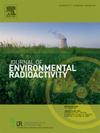对来自受放射性污染水库的蟑螂进行骨骼和头部肾脏辐射剂量测定:方法制定与应用
IF 1.9
3区 环境科学与生态学
Q3 ENVIRONMENTAL SCIENCES
引用次数: 0
摘要
为了建立辐射照射与组织效应之间的因果关系,有必要计算对关键器官和组织的剂量,并评估剂量-效应关系。目前存在的非人类生物群剂量测定工具没有考虑到器官和组织之间的不均匀放射性核素分布。本研究在评估目标器官形态参数的基础上,开发了蟑螂体段的计算体模。脊柱、肋骨和头部肾脏被认为是辐射照射对骨骼和血液系统影响的靶器官。基于电子和光子输运的蒙特卡罗模拟,计算了将90Sr和137Cs掺入物的比活度转化为靶器官剂量率的剂量因子。骨组织中90Sr浓度为1 Bq/g时,头肾、肋骨和脊柱的剂量率分别为1.98、3.38和7.49 μGy/d。137Cs在骨骼中的积累导致骨特异性剂量率比相同浓度90Sr的剂量率低3-4倍。用所得结果计算了乌拉尔地区两个放射性污染水体对蟑螂的剂量。最大剂量为典型的椎体(1.4±0.2和27.0±8.3 mGy/天)。它们是头肾和肋骨剂量的1.4-3倍。可以预期,辐射暴露对椎体的骨骼影响比鱼的肋骨更明显,在环境中存在锶同位素的情况下,它们应被视为单独的靶器官。本文章由计算机程序翻译,如有差异,请以英文原文为准。
Bone and head kidney radiation dosimetry for roach from radioactively contaminated reservoirs: Method elaboration and application
To establish causal relationships between radiation exposure and tissue effects, it is necessary to calculate the doses to critical organs and tissues and to evaluate the dose-effect relationship. The tools of non-human biota dosimetry that exist nowadays do not take into account the heterogeneous radionuclide distribution between organs and tissues. In the current study, a computational phantom of the roach body segment was developed based on the assessment of the morphometric parameters of target organs. The spine, ribs and head kidney were considered as target organs for bone and hematological effects of radiation exposure. The dose factors to convert specific activity of incorporated 90Sr and 137Cs to dose rates in target organs were calculated based on Monte Carlo simulation of electron and photon transport. One Bq/g of 90Sr in bone tissue lead to dose rates equal to 1.98, 3.38 and 7.49 μGy/day in the head kidney, ribs and spine, respectively. The accumulation of 137Cs in the bones results in bone-specific dose rates that are 3–4 times lower than those at the same concentration of 90Sr. The obtained results were used to calculate doses to the roach from two radioactively contaminated waterbodies of Ural region. Maximum doses were typical of vertebra (1.4 ± 0.2 and 27.0 ± 8.3 mGy/day). They were 1.4–3 times higher than doses head kidney and ribs. One can expect more pronounced bone effects of radiation exposure in the vertebral bodies than in the ribs of fish, and they should be considered as separate target organs in the presence of Strontium isotopes in the environment.
求助全文
通过发布文献求助,成功后即可免费获取论文全文。
去求助
来源期刊

Journal of environmental radioactivity
环境科学-环境科学
CiteScore
4.70
自引率
13.00%
发文量
209
审稿时长
73 days
期刊介绍:
The Journal of Environmental Radioactivity provides a coherent international forum for publication of original research or review papers on any aspect of the occurrence of radioactivity in natural systems.
Relevant subject areas range from applications of environmental radionuclides as mechanistic or timescale tracers of natural processes to assessments of the radioecological or radiological effects of ambient radioactivity. Papers deal with naturally occurring nuclides or with those created and released by man through nuclear weapons manufacture and testing, energy production, fuel-cycle technology, etc. Reports on radioactivity in the oceans, sediments, rivers, lakes, groundwaters, soils, atmosphere and all divisions of the biosphere are welcomed, but these should not simply be of a monitoring nature unless the data are particularly innovative.
 求助内容:
求助内容: 应助结果提醒方式:
应助结果提醒方式:


